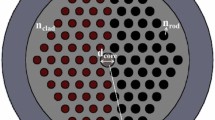Abstract
We discovered that a specific transmission mode in the fiber waveguide will split into two modes at near cut-off conditions when the fiber is coated with lossy dielectric nanofilms with higher refractive index. One of the two splitting modes is high lossy while the other is slightly lossy. We defined the “mode splitting coefficient” to describe the degree of mode splitting. We found that the biggest mode splitting coefficient was obtained at the mode cut-off wavelength using finite element method. Finally, we put forward an explanation towards the mode splitting phenomenon and expounded the relationship between the mode splitting and mode coupling.






Similar content being viewed by others
References
Low T, Chaves A, Caldwell JD, Kumar A, Fang NX, Avouris P, Heinz TF, Guinea F, Martin-Moreno L, Koppens F (2017) Polaritons in layered two-dimensional materials. Nat Mater 16:182–194
Liu X, Galfsky T, Sun Z et al (2014) Strong light–matter coupling in two-dimensional atomic crystals. Nat Photonics 9(1):30–34
Yang K, Chau YF, Huang Y et al (2011) Design of high birefringence and low confinement loss photonic crystal fibers with five rings hexagonal and octagonal symmetry air-holes in fiber cladding. J Appl Phys 109:093103
Yang TJ, Chau YF, Yeh HH et al (2011) Dispersion properties, birefringence and confinement loss of rotational elliptic air-hole photonic crystal fiber. Appl Phys A Mater Sci Process 104:857–861
Verma S (2019) All-circular hole microstructured fiber with high birefringence and low confinement loss. Appl Opt 58(14):3767–3774
Anas MT, Asaduzzaman S, Ahmed K et al (2018) Investigation of highly birefringent and highly nonlinear Hexa Sectored PCF with low confinement loss. Results Phys 11:1039–1043
Chau YF, Liu CY, Yeh HH et al (2010) A comparative study of high birefringence and low confinement loss photonic crystal fiber employing elliptical air holes in fiber cladding with tetragonal lattice. Prog Electromagnet Res B 22:39–52
Sun YS, Chau YF, Yeh HH et al (2008) Highly birefringent index-guiding photonic crystal fiber with squeezed differently sized air-holes in cladding. Jpn J Appl Phys 47:755–3759
Wang Q, Zhao WM (2018) A comprehensive review of lossy mode resonance-based fiber optic sensors. Opt Lasers Eng 100:47–60
Jing JY, Wang Q, Zhao WM (2019) Long-range surface plasmon resonance and its sensing applications: a review. Opt Lasers Eng 112:103–118
Wang Q, Jing JY, Wang BT (2019) Highly sensitive SPR biosensor based on graphene oxide and staphylococcal protein a co-modified TFBG for human IgG detection. IEEE Trans Instrum Meas 68(9):3350–3357
Batchman TE, Mcwright GM (1982) Mode coupling between dielectric and semiconductor planar waveguides. IEEE T Microw Theory 30(4):628–634
Carson RF, Batchman TE (1990) Multimode phenomena in semiconductor-clad dielectric optical waveguide structures. Appl Opt 29(18):2769–2780
Razansky D, Einziger PD, Adam DR (2005) Broadband absorption spectroscopy via excitation of lossy resonance modes in thin films. Phys Rev Lett 95:018101
Arnold C, Zhang Y, Rivas JG (2010) Long range surface polaritons supported by lossy thin films. Appl Phys Lett 96:113108
Arnold C, Rivas JG, Offermans P, Rivas JG (2012) Surface wave sensors based on nanometric layers of strongly absorbing materials. Opt Express 20(9):9431–9441
Chau YF, Yeh HH, Tsai DP (2007) Significantly enhanced birefringence of photonic crystal fiber using rotational binary unit cell in fiber cladding. Jpn J Appl Phys 46:L1048–L1051
Shen LF, Yang TJ, Chau YF (2007) 50/50 beam splitter using a one-dimensional metal photonic crystal with parabolalike dispersion. Appl Phys Lett 90:251909
Shen LF, Yang TJ, Chau YF (2008) Effect of internal period on the optical dispersion of indefinite-medium materials. Phys Rev B 77(20):205124
Wang Q, Zhao WM (2018) Optical methods of antibiotic residues detections: a comprehensive review. Sensors Actuators B Chem 269:238–256
Wang Q, Li X, Zhao WM et al (2019) Lossy mode resonance-based fiber optic sensor using layer-by-layer SnO2 thin film and SnO2 nanoparticles. Appl Surf Sci 492:374–381
Wang Q, Jing JY, Wang XZ et al (2019) A D-shaped fiber long-range surface plasmon resonance sensor with high Q-factor and temperature self-compensation. IEEE Trans Instrum Meas. https://doi.org/10.1109/TIM.2019.2920187
Synowicki RA (1997) Spectroscopic ellipsometry characterization of indium tin oxide film microstructure and optical constants. Thin Solid Films 313:394–397
Paliwa N, John J (2015) Lossy mode resonance (LMR) based fiber optic sensors: a review. IEEE Sensors J 15(10):5361–5371
Chakma S, Khalek MA, Paul BK et al (2018) Gold-coated photonic crystal fiber biosensor based on surface plasmon resonance: design and analysis. Sens Bio-Sens Res 18:7–12
Corres JM, Villar ID, Arregui FJ, Matias IR (2015) Analysis of lossy mode resonances on thin-film coated cladding removed plastic fiber. Opt Lett 40(21):4867–4870
Hernáez M, Villar ID, Zamarreño CR et al (2010) Optical fiber refractometers based on lossy mode resonances supported by TiO2 coatings. Appl Opt 49(20):3980–3985
Zhu S, Pang FF, Huang SJ et al (2017) High sensitivity refractometer based on TiO2-coated adiabatic tapered optical fiber via ALD technology. Sensors 16:1295
Tiwaria D, Mullaney K, Serhiy K et al (2017) An ammonia sensor based on lossy mode resonances on a taperedoptical fibre coated with porphyrin-incorporated titanium dioxide. Sensors Actuators B Chem 242:645–652
Funding
This work was supported by the Fundamental Research Funds for the Central Universities under Grant N180402023, the National Natural Science Foundation of China under Grant 51607028.
Author information
Authors and Affiliations
Corresponding author
Additional information
Publisher’s Note
Springer Nature remains neutral with regard to jurisdictional claims in published maps and institutional affiliations.
Rights and permissions
About this article
Cite this article
Zhao, WM., Wang, Q., Jing, JY. et al. Discoveries and Explorations of Mode Splitting Phenomenon in Lossy Dielectric Waveguide. Plasmonics 15, 481–487 (2020). https://doi.org/10.1007/s11468-019-01063-z
Received:
Accepted:
Published:
Issue Date:
DOI: https://doi.org/10.1007/s11468-019-01063-z




